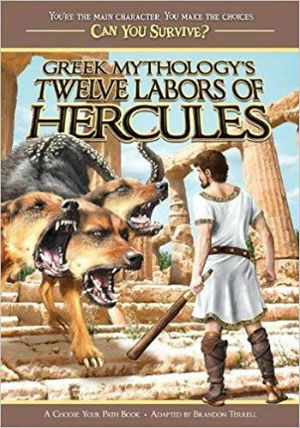Dateline: Bethlehem
When the Myth Became Fact and Dwelt Among Us
By Neil Earle

Do you remember the TV shows “Hercules” and “Xena the Warrior Princess?”
They were a staple of prime time TV programming in the late 1990s. The catchy secret to their extra-human powers was their demigod status – that is, they were part-god and goddess through an intermixing of the human and divine. The pre-Christian world, as we all know, redounded with tales of the gods coming down to sport themselves with humans on occasion. Thus there was the Greek hero, Perseus, a product of a match between the father of the gods, Zeus himself, and a local beauty. Then there was Achilles, and so on. There is even a semi-humorous reference to this Greek idea of the gods appearing among men in the book of Acts 14:8-18 where Paul is mistaken for Hermes and Barnabas for Zeus.
A Bethlehem Myth?
May we then speak of a “Bethlehem myth?” The myth of the gods appearing among human beings in many guises and disguises is a common theme in the literature of antiquity. My point here is that when the world’s fund of knowledge skyrocketed after the discoveries and encounters with other cultures of the 1500s and 1600s, more than one skeptic began to draw parallels between the pagan myths of the nations and the Bethlehem story. As we entered the 20th century even some church thinkers confined the Bethlehem event and the incarnation of Christ to the realm of myth. “Just another tale of the gods coming to earth,” they said. “Understandable for the thought world of the early church.”
The radical theologian Rudolph Bultmann (1884-1976) proposed that the entire New Testament needed to be decoded or “demythologized” to get at its deeper, spiritual meaning. This line of reasoning – in effect linking Hercules, Xena and the child of Bethlehem – demanded a response from more orthodox Christians.
Christian thinkers such as R.K. Harrison, C.S. Lewis and John Stott and others began to point out how even the earliest creeds of the church had been erected as a bulwark, in part, against such ideas arising. The Niceno-Constantinopolitan Creed of 381 A.D., for example, attested to Jesus Christ as “the only-begotten Son of the Father, begotten from the Father before all time…of the same essence as the Father.” Another Council of 451 dealt with the two natures of Jesus, humans and divine, as being “without separation, without change, without partition, without confusion” (See John H. Leith’s Creeds of the Churches, pages 33, 51). The Anglican Article 2 declared that at the Incarnation “Godhead and Manhood were joined together in one Person, never to be divided.”
 Able scholars such as Roland K. Harrison have refuted the wildest charges against the Bethlehem story.
Able scholars such as Roland K. Harrison have refuted the wildest charges against the Bethlehem story.A Prime Distinctive
Bultmann’s bold theologizing had given evangelical thinkers a platform to engage more positively with the key doctrine called Incarnation (“In”- “Carnu” = flesh) all over again. The English writer J.I. Packer wrote of “the really staggering Christian claim…that Jesus of Nazareth was God made man (sic) and that he took humanity without loss of deity…[T]he divine Son became a Jew; the Almighty appeared on earth as a helpless human baby, unable to do more than lie and stare and wiggle and make noises, needing to be fed and changed and talked to like any other child.” Packer went on: “This is the real stumbling block of Christianity. It is here that Jews, Muslims, Unitarians, Jehovah’s Witnesses…feel the difficulties and have come to grief” (Knowing God, page 53).
Packer is right. The Incarnation is a prime distinctive of Christianity. Muslims know this well. On the Dome of the Rock in Jerusalem there are emblazoned written inscriptions that say “Praise be to God who begets no Son and has no partner…He is one God, eternal, He is not begotten and has no peer.” This, of course, is in direct contradiction of Hebrews 1:4 which asserts: “For to which of the angels did He ever say, You are my Son, today I have begotten you” (Hebrews 1:5, NAV).
Muslims in particular know what is at stake when Christians claim that Jesus was the incarnate God. That would have meant that Christ preempted Mohammed by some 600 years, and not as a Prophet but as someone much more than a prophet. There is thus a lot at stake in the Bethlehem story. Bethlehem led to Calvary and Calvary to Christ’s resurrection and ascension. These prime Christian distinctives flow from the virgin birth at Bethlehem. As Luke 1:78 put it: “The Dayspring from on high has visited us; to give light to those who sit in darkness and the shadow of death, to guide our feet into the ways of peace.”
All Parallels Break Down
Indeed, it was something as simple and familiar as the Bethlehem Story that had a great impact in the conversion of the Christian writer C.S. Lewis. Lewis was a famed student of ancient mythology. After his conversion the so-called “pagan parallels” he well knew from teaching literature at Oxford began to fit. He began to see more in Hercules and Xena than most:
“The heart of Christianity is a myth which is also a fact. The old myth of the Dying God…comes down from the heaven of legend and imagination to the earth of history. It happens – at a particular date, in a particular place, followed by definable historical consequences. We pass from a Balder or an Osiris, dying nobody knows when or where, to a historical Person crucified under Pontius Pilate…God is more than a god, not less; Christ is more than Balder, not less. We must not be nervous about ‘parallels’ and ‘pagan Christs’: they ought to be there…addressed to the savage, the child, and the poet in each one of us no less than to the moralist, the scholar, and the philosopher” (God in the Dock, pages 43-45).
From earliest times, Lewis was saying, the world sensed its need for a savior. What the pagans had dimly intuited, the Bethlehem story loudly proclaimed. We pass, with the Incarnation, from myth to history, but no pagan mythmaker could have foreseen where Bethlehem would lead. The parallels quickly get superseded by the strange beauty of the Gospel message:

- The Incarnation meant that Jesus was not God minus divinity but God plus our humanity “so that by his death he might destroy him who holds the power of death, that is, the devil – and free those who all their lives were held in slavery by their fear of death” (Hebrews 2:14-15). That Hercules and Xena could not do. In the really sensational Christian claim, early theologians asserted that Jesus’ sharing our humanity made possible humanity’s ultimate ascent to a form of divinity through spiritual union with him already (1 John 2:17).
- Jesus came into humble circumstances – neither a mighty warrior nor an invincible strongman. There was no room at the inn. The child of promise was placed in a manger. The omnipotent Creator was confined to a straw crib. The lesson was this: a new force had entered history – the pierced hand would triumph over the clenched fist. The cross of death would become the symbol of conquest!
- The Prince of Peace soon became the target of brutal violence, of a murderous purge unleashed against the innocent children of Bethlehem (Matthew 2:16-18). What a welcome for the King of Kings, the One they eventually put to death. What a lesson in fully sharing our humanity and being “God with us” as opposed to legendary feats of invincible strength, such as the twelve labors of Hercules.
- Jesus was a refugee and thus became identified with all true refugees then and since. He and his family were forced to flee to Egypt (Matthew 2:13-15). By that suffering he threw in his lot with all true sufferers.
- Jesus was a willing sacrifice not a victim. He was not the sad victim given to appease a stern God but the perfect Lamb of God eager to atone and willing to give himself in love. Jesus thus “won by losing” and by so doing his perfect sacrifice reconciled humanity back to God. Jesus whole life and sacrificial death was a kind of self-imposed humiliation the Greek and Roman myths could only begin to comprehend!

Beyond all Human Imagining
Still, even orthodox theologians saw that Rudolph Bultmann did have some things right. The events surrounding the Incarnation do stretch our credulity. The implications are outside our modes of thought – pagan, modern and postmodern. But part of the surprising good news of the Gospel is this: God triumphs in the unexpected. Another German theologian, Jurgen Moltmann, eclipsed what Bultmann was saying by showing the titanic stakes involved at Bethlehem:
“In antiquity the divine being was not a problem. Its existence was rarely doubted. It was man in his relationship to God which was the problem. …The mystery of Jesus here is the incarnation. The next step was from the general question of God to the mystery of Jesus, the incarnation of eternal, original, unchangeable being in the sphere of temporal, decaying, transitory existence, in which men live and die…God became man so that men could partake of God (1 Peter 1:4)” (The Crucified God, page 88).
Moltmann is right. Christ’s becoming flesh in Bethlehem blew the ancient world’s thought patterns sky high. Depend on it. It was never part of pagan mythology that God should become man for the purpose of “emptying himself,” (Philippians 2:6-7), of becoming a human being and submitting to all that that would mean in the hateful hands of sinful men. Hercules, Xena, Achilles – their creators did not, could not, think in such terms. Yet in the fullness of time God sent us a Rescuer and a Redeemer far more potent than all that myth and legend could conceive. It was the grand miracle. Jesus Christ, our Emanuel, fully God and fully man, born through the will of God and a miracle called Incarnation!